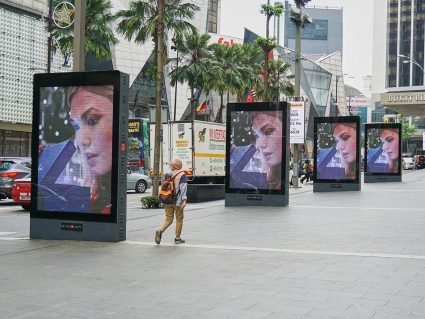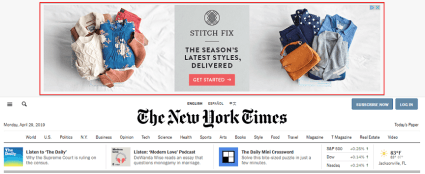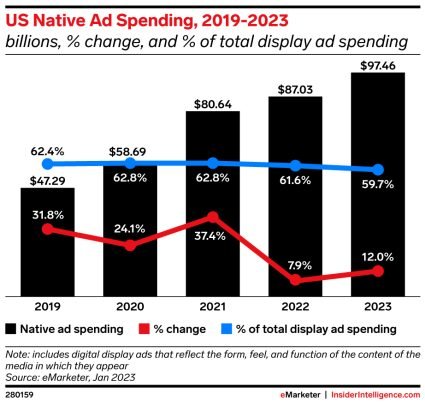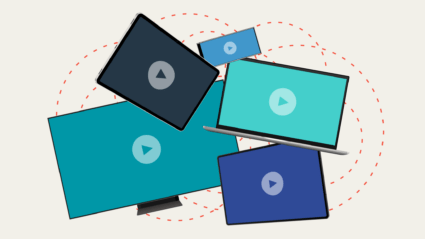Choosing the right ad formats is a key part of planning any programmatic media campaign. From display ads to audio storytelling to connected TV, different ad formats have different advantages, price points, and roles in the funnel.
With all these options, how can you choose the ad formats that will be the most effective for your brand and budget? We’ve put together the benefits and downsides of some top programmatic ad formats to help you choose your fighter for your brand’s next big advertising push.
Drive awareness with dynamic digital out-of-home (DOOH) advertising
If your brand is looking to catch the attention of a large range of potential customers, digital out-of-home (DOOH) advertising might be the format for you.
Unlike the static billboards or posters of traditional OOH advertising, DOOH ads offer an opportunity to make the most of eye-catching visuals and real-time updates, keeping your message fresh and impactful. Since advertisers can automate DOOH buying through software and make updates to the creative remotely in response to changing circumstances, it also gives brands more agility in planning and execution.

Source: The Trade Desk
Advertisers can also use data analytics to measure the effectiveness of their DOOH campaigns. With traditional OOH ads, publishers weren’t transparent about pricing adjustments based on variables like traffic changes, making it challenging to forecast the impact of the ad. Since DOOH campaigns have the technology to monitor dwell time and how many people are moving in front of screens, publishers can now share deeper insights into an ad’s reach.
But it can still be hard to measure impact for DOOH campaigns since they’re upper funnel activations built to drive brand awareness rather than conversions. For insight into an ad’s efficacy, marketers can look to signals like local brand search trends or social chatter; but more substantial results require much longer time windows.
Elevate your brand’s presence with over-the-top (OTT) ads
For brands looking to engage audiences more directly, over-the-top (OTT) advertising delivers ads to viewers with precision and impact. The proliferation of streaming services gives advertisers an opportunity to optimize spend by reaching their customers in their preferred content environments.
With these options, it’s no wonder that OTT is quickly becoming the dominant TV advertising opportunity. But it comes with its own potential challenges: US households subscribe to four streaming services on average, according to Deloitte.
The many service choices for viewers can make it tough for advertisers to decide which platforms to invest in, especially since most platforms are siloed. Advertisers need to take an audience-first approach to media planning that’s driven by data. When you have a strong sense of who the consumer is and how they watch, your brand can connect with them on different publishers.
Luckily, the wide range of streaming options has also ushered in a lot more advertiser control over inventory access and ad placement. In the past, advertisers had to go through the network upfront process and make commitments to spend well in advance. Today you can access all kinds of networks, so your TV dollars can drive higher reach and greater frequency.
Get engaged audience attention with audio storytelling
If you want more engaged attention from potential customers, look no further than audio ads. Audiences listening to audio (like podcasts) are more focused on the content and less likely to disconnect during hard-to-skip ads, making the format a great upper and mid-funnel activation to drive awareness and consideration.
Audio is an especially good option for companies implementing brand lift campaigns. According to Nielsen, the top 10% of brand lift campaigns tend to have nearly three-quarters of their impressions tied to audio. Campaigns with a majority of audio impressions also drive higher sales lift, ROAS, reach, and frequency than other campaign types, according to NC Solutions and Oracle.
Audio ads also offer brands a place to get creative. Since there’s no visual element, these ad formats lend themselves to weirder, more engaging ads that capitalize on trends like ASMR or soundscapes.
For example, DIRECTV used the format of relaxing sleep podcasts for their “Sack the Sunday Scaries” campaign with Travis Kelce, which gave football fans the chance to unwind after game day with calming clips like Kelce blowing a whistle softly or repeating “bruh” over a soothing soundscape.
With podcast placements, brands also have an opportunity to use the host’s personality and relationship with their audience to build loyalty with customers. An ad read by the host feels less intrusive and more organic to the listener, and these spots can have a halo effect on their listeners by playing off the host’s charisma.
Pull customer attention with visually appealing display ads
Display ads have been a less popular type of programmatic spend recently, with the market growing only 8% this year according to eMarketer. However, this ad format still has benefits for advertisers looking to showcase their products in high-visibility placements. Consider adding display ads to your media mix if your brand wants to complement other channels with additional visibility.
Display ads can grab attention for your products, key value propositions, or promotions with eye-catching placements like banners and rich media formats. And they’re especially powerful on increasingly popular retail media networks, where your ads are closer to the point of purchase.
If your brand is dipping a toe into display ads, rich media can be a smart place to invest. Since these ads include additional attention-grabbing elements like video and audio, they catch more customer interest than static ads, leading to higher conversions and view rates. Rich media can also give you more advanced metrics than regular display ads by tracking user interactions like how many times someone expanded the ad or completed a video.

Source: WebFX
Since display ads are dynamic, you can change your visuals, CTA, or message even after an ad starts running. That means if one element of a campaign proves less effective, you can update the ad to improve returns and optimize your campaigns.
This flexibility also makes display ads a good way to test creatives to see which perform best with your audience. You can launch multiple display ads with different elements to determine which resonates the most, then use that information to update other display ads or incorporate those elements into ad formats that are harder to test.
Blend right in with native ads
Similar to display ads, native ads promote your products and services where customers are scrolling online. But native ads have an added advantage: they seamlessly blend with the content of the platform.
Customers absorb these non-disruptive ads as part of their regular viewing experience, rather than being tipped off by more obvious traditional display ads. Instead of scrolling straight past, users are more likely to absorb the content you’re promoting–according to a study by Sharethrough/IPG Media labs, consumers looked at native ads 53% more often than display ads.
Because of their high viewership, native ads are a good place to invest for brands looking to get on an audience’s radar. That’s why native ads account for 59.7% of total display ad spending, according to eMarketer.

Source: eMarketer
Your brand can jump into native with ads like in-feed sponsored content within a gallery of otherwise organic posts; featured recommendations on sites like Amazon; or paid search units on the SERP.
But before making any moves, keep in mind that native ads are generally pricier per click than traditional display ads, so you should be mindful of how you choose to invest your ad dollars. Native ads can be an important component of your media mix, but consider incorporating lower-cost ads into your strategy or testing out your creative in cheaper display ads before going all in on native placements.
No matter which ad format you choose, it’s important to keep trying out different creative and messaging to determine what resonates the most with your audience. You can then leverage those learnings across every channel in your media mix.
You should also experiment with multiple different ad formats over time, depending on what performs best–they all have different benefits that might work for your brand depending on your campaign objectives. The worst thing you can do for your marketing is get stuck in a creative rut with the same things you’ve always done.







Responses